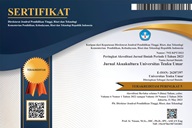PENGGUNAAN TEPUNG MAIZENA, TAPIOKA DAN BERAS SEBAGAI SUMBER KARBON PADA BIOFLOK UNTUK PERTUMBUHAN IKAN NILA (Oreochromis niloticus)
Abstract
Full Text:
PDFReferences
Avnimelech, Y. 1999. C/N Ratio As a Control Element in Aquaculture Systems. Aquaculture. 176: 227-235.
Avnimelech Y. 2006. Bio-filter: The need for an new comprehensive approach. Aquacultural Engineering. 36:172 – 178.
Azim, M.E. & D.C. Little. 2008. The Biofloc Technology (BFT) In Indoor Tanks: Water Quality, Biofloc Composition, and Gowth and Welfare of Nile Tilapia (Oreochromis niloticus). Aquaculture 283: 29–35.
BSN. 2009. Produksi Ikan Nila (Oreochromis niloticus Bleeker) Kelas Pembesaran di Kolam Air Tenang. BSN (Badan Standardisasi Nasional). SNI 7550:2009. 12 hlm.
De Schryver, P.D, R. Crab, T. Defoird, N. Boon, & W.Verstraete. 2008. The Basic of Bioflock Technology : The Added Value For Aquaculture. Aquaculture 277: 125 – 137.
Effendi, M. I. 2003. Telaah Kualitas Air Bagi Pengelolaan Sumber Daya dan Lingkungan Perairan. Kanisius, Yogyakarta. 258 hlm.
Hastuti, S., & Subandiyono. 2014. Performa Produksi Ikan Lele Dumbo (Clarias gariepinus, Burch) Yang Dipelihara Dengan Teknologi Bioflok. Indonesian Journal of Fisheries Science and Technology 10 (1): 37-42.
Rohmana D, S. Hanif, B. Rachman, S. & Rosellia . 2010. Aplikasi Teknologi Biofloc (BFT) Pada Pendederan Intensif Ikan Nila dan Udang Galah. Makalah disampaikan pada Seminar Indoaqua. Kementrian Kelautan dan Perikanan Republik Indonesia. Bandar Lampung.
Purnomo, P.D. 2012. Pengaruh Penambahan Karbohidrat pada Media Pemeliharaan Terhadap Produksi Budidaya Intensif Nila (Oreochromis niloticus). Journal of Aquaculture Management and Technology 1 (1):
-179.
Suryaningrum, F.M. 2014. Aplikasi Teknologi Bioflok pada Pemeliharaan Benih Ikan Nila (Oreochromisniloticus). Jurnal Manajemen Perikanan dan Kelautan 1 (1).
Zakaria, M. W. 2003. Pengaruh Suhu Media Yang Berbeda Terhadap Kelangsungan Hidup dan Laju Pertumbuhan Benih Ikan Nilem (Osteochilus hasselti C.V.) Hingga Umur 35 Hari. Institut Pertanian Bogor. Bogor.
DOI: https://doi.org/10.35308/ja.v5i1.3888
Refbacks
- There are currently no refbacks.



